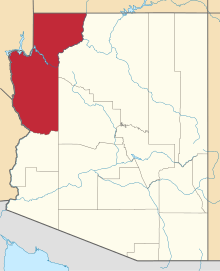Aubrey Landing, Arizona
| Aubrey Landing, Arizona | |
|---|---|
| Ghost town | |
 Aubrey Landing, Arizona | |
| Coordinates: 34°18′00″N 114°04′39″W / 34.30000°N 114.07750°WCoordinates: 34°18′00″N 114°04′39″W / 34.30000°N 114.07750°W | |
| Country | United States |
| State | Arizona |
| County | Mohave |
| Founded: | circa 1860 |
| Abandoned: | circa 1886 |
| Named for | Francois Xavier Aubrey |
| Elevation[1] | 646 ft (197 m) |
| Time zone | MST (no DST) (UTC-7) |
| Post Office Opened: | October 2, 1866 |
| Post Office Closed: | November 3, 1886 |
Aubrey Landing, Aubrey City or Aubrey is a ghost town at the mouth of the Bill Williams River in southern Mohave County, Arizona. The town was founded before 1865 and was abandoned sometime after 1886.[2] Aubrey Landing was inundated when Lake Havasu was formed.[1]
History
Aubrey Landing was the first construction that became the town of Aubrey City sometime before 1865 during the Civil War in Arizona. The unknown founder named the river settlement after Francois Xavier Aubrey, a famous American pioneer from a decade earlier. The town was ideally located on the east bank of the Colorado River at its confluence with the Bill Williams River, on the north bank of the Bill Williams River. It was 12.5 miles from the Planet Company copper mines, 11.2 miles from the Mineral Hill mines and 9.6 miles from the Empire Flats mines.[3]
In 1865, a break in copper prices left the town almost deserted. However enough people stayed in Aubrey City and the nearby mines, prompting establishment of the Aubrey post office in 1866. Little had changed though by 1878, the town never grew to the size anticipated by the owners. The town consisted of the usual mining camp structures, as well as a hotel, saloon and a general store. The town supported a small population for almost ten years more. In 1886 the post office closed and the town soon after.[2]
The site today
The site of this old river landing and mining town is lost below Lake Havasu.
GNIS location of site in error
The Official GNIS location of 34°18′00″N 114°04′38″W / 34.30000°N 114.07722°W,[1] is obviously incorrect, not being located at the confluence of the Colorado and Bill Williams Rivers or even under Lake Havasu. Given the evidence of the 1866 Edward Fairman map and drawing it should be located at 34°18′15″N 114°08′17″W / 34.30417°N 114.13806°W directly north of Parker Dam.[4]
References
- ↑ 1.0 1.1 1.2 U.S. Geological Survey Geographic Names Information System: Aubrey Landing (historical)
- ↑ 2.0 2.1 Sherman, James E; Barbara H. Sherman (1969). Ghost Towns of Arizona. University of Oklahoma Press. ISBN 0-8061-0843-6.
- ↑ Map of confluence of Williams Fork and Colorado River, Arizona Terr[itor]y..., by Edward Fairman, artist. Date: 1866. From: Robert B. Honeyman, Jr. Collection of Early Californian and Western American Pictorial Material, UC Berkeley, Bancroft Library, accessed April 19/2015.
- ↑ Aubrey City, Williams Fork, Arizona Territory, by Edward Fairman, artist Date: 1866. Drawing on paper: pen and ink 48.4 x 64.6 cm. Bancroft Library.
External links
- Official Map Of The Territory Of Arizona, With All The Recent Explorations. Compiled by Richard Gird C.E. Commissioner. Approved By John N. Goodwin, Governor. In Accordance With An Act Of The Legislature, Approved Oct. 23d. 1864. We hereby certify that this is the Official Map of the Territory of Arizona, and approve the same. Prescott October 12th 1865. (with signed seal dated 1863). Published By A. Gensoul, Pacific Map Depot. No. 511 Montgomery St. San Francisco. Lith. Britton & Co. San Francisco. Accessed from www.davidrumsey.com, December 1, 2014. Shows location of Aubrey City and other landings, settlements and the mining districts along the Colorado River and the interior of the territory in 1865.
| |||||||||||||||||||||||||||||||||||||
